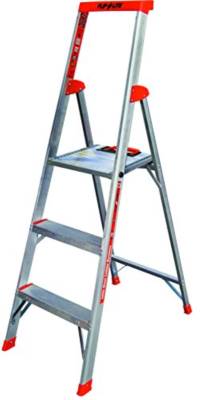Jump to Winner of Step Ladder Top 10 Rankings!
Types of ladder
Step ladders are the most commonly used ladder in the industry for they do not need to be leaned against any type of support when in use.
Extension ladders most be leaned against some type of support; as a house, wall, or tree before it can be used. Extension ladder is able to reach higher than you may first think when you see it with its fly.
A higher level of comfort is provided by Platform ladders while you are standing on a ladder for any amount of time. Platform ladder allows you to work on any project that requires the use of two hands as safely as if you were on the ground.
Multi-purpose ladders accomplish the tasks of two or more of the other types of ladders when completing different tasks around the house or on the job.
Telescoping ladders allow you to slide in and out to adjust in size by the use of overlapping sections. Telescoping ladder can be fully extended like an extension ladder for desired distance and it can shrink when you need very compact ladder.
Folding Ladders are folded up when not in use for extremely easy storage. Folding ladder is light weight, easy to use, convenient and safe around the house.
Choosing a step ladder
When choosing the right ladder for the job; consider the ladders’ styles, sizes, grades and materials.
Style: When you need a reach of about two to eight feet, a stepstool, a stepladder, folding ladder, platform ladder, telescoping ladder or multi-purpose ladder is recommended for the task; but when a reach of thirteen feet or more outside are needed, a taller stepladder, multi-purpose or extension ladder is often more right for the tasks.
Size: Purchasing a ladder that is either too short or too long is one of the most common and potentially dangerous mistakes committed when it comes to ladder selection.
Grades: They are given to ladders referring to the definition of their duty ratings as to their maximum safety load capacity.
Material: Considered as the best option, fiberglass is electrically and non-conductive in great value is the leading choice of professionals; aluminum is strong, lightweight, corrosion-resistant; and wood, when clean and dry. Is an economical, electrically and non-conductive material.
Step ladder safety
1. Before climbing the ladder, make sure that it is sound and in good working condition with order no broken or missing parts and is not leaning to one side.
2. For home projects inside, it is wiser to use a step stool especially if you have problem in balancing as step stools have wider steps so it is easier to climb.
3. When you climb a step ladder, always wear stable, supportive, slip-resistant shoes with clean, heavy soles; never go up the ladder with bare feet or using flip flops or wearing sandals.
4. An even stable surface is the right place to set your ladder; never on soft uneven ground nor in front of a closed door that opens toward the ladder.
5. While climbing the ladder, keep one hand and two feet or one foot and two hands always on the ladder to allow maintaining your grip on the ladder if ever you slip.
6. Once on top of the ladder, do not attempt to reach object outside of your reach; instead, climb down carefully and reposition the ladder so that you can easily reach what you need.
7. Remember when the job is too complicated, call in a pro to do a hard job that requires working on a ladder.
From placing the star on top of your Christmas tree to trimming hedges in your garden, everyday life calls for a stepladder. Know the best ladders that fit the job and observe safety to get the most out of this useful tool.

